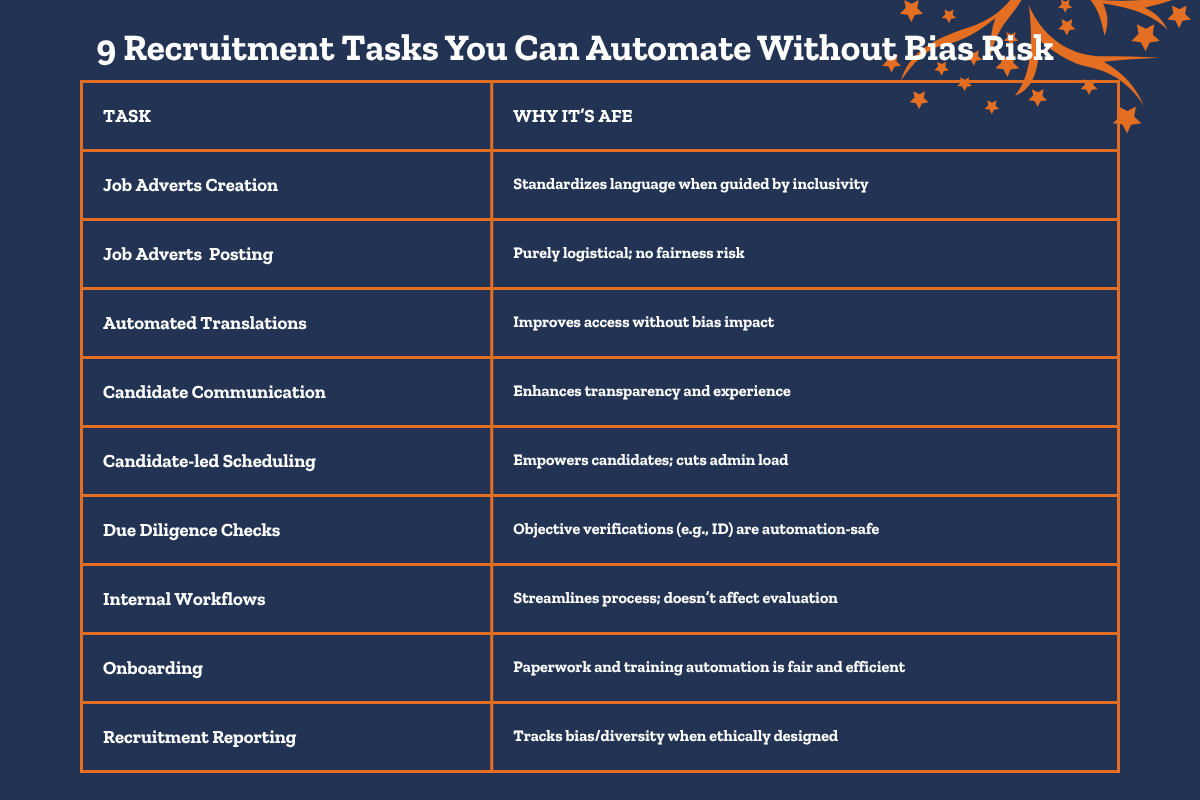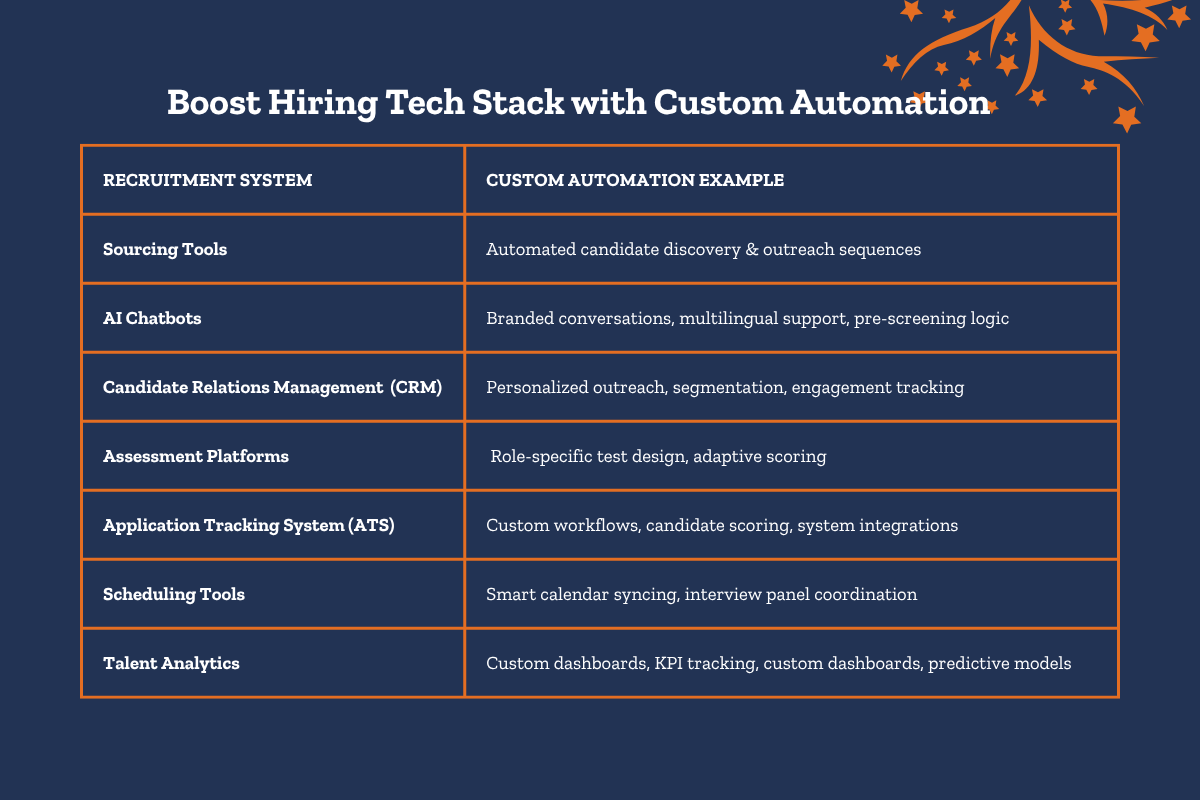
- Intelligent Automation
- Written By Namita Bhagat
Recruitment Process Automation: How to Address Hiring Bias & Build Fairness
24-Jul-2025 . 8 min read
When it comes to recruitment process automation, many businesses aren’t sure what—or how much—they should automate. Concerns around regulations and candidate wariness only add to the dilemma for business leaders and HR heads.
Yet roles need to be filled fast—before top talent walks away, hiring costs escalate, or work stalls for too long!
But handling every task manually, especially with high application volumes, is painfully slow. And let’s face it: in today’s world of speed and precision, hiring shouldn’t take weeks or months.
It’s no surprise, then, that more organizations now view automation as a key part of their hiring strategy.
In this guide, you’ll discover which recruitment tasks are ideal for automation, how to safeguard against bias, and how to design a hiring process that’s not just efficient—but also fair and future-ready.
Where Bias, Fairness, and Recruitment Process Automation Meet
A bias-free recruitment system is critical to ensuring organizations don’t miss out on talent, suffer from a lack of diversity, or face legal risks. Strikingly, hiring bias and fair hiring are like opposite ends of the recruitment pipeline—one creates blockages, the other clears the way.
An old proverb goes: There’s more than meets the eye!
However, hiring systems—whether human-led or machine-driven (e.g., candidate assessment tools and applicant tracking systems (ATS))—might subscribe only to what’s obvious.
Interestingly, stereotypes and clouded human perception and judgment can reflect in automated hiring systems through biased algorithms too. Even when an organization avoids intentional bias, unintentional bias can still creep into hiring decisions.
It’s a loss when an organization unknowingly misses out on exceptional candidates—just because they don’t tick every conventional box, even if they might be a better fit for the role.

So, it is critical to automate your hiring processes thoughtfully using the right tools and system design practices. Because a well-made recruitment automation system helps:
- Explore a diverse set of potential candidates
- Alleviate applicants’ concerns vis-à-vis automated hiring
- Fast-track recruitment while reducing hiring costs
- Align with recruitment AI regulatory landscapes
- Protect and boost employer brand reputation
A Strong Case for Automated Hiring Despite Skepticism
Benefits, bias risk, and loss of control are the top considerations and concerns one may be looking at. Let’s go over these one by one and see what makes a strong case for automating hiring — despite skepticism or reservations.
1. Key Advantages? The inarguable benefits of recruitment automation!
- Speed & Scale: Automation handles high volumes of applicants quickly.
- Consistency: Reduces human inconsistency in screening and scheduling.
- Cost Optimization: Reduces time-to-hire and minimizes manual effort, leading to more efficient resource utilization and lower recruitment costs.
2. Bias Risk? Ensure fairness via design and regular monitoring!
- Inclusive Training Data: Diverse datasets and fair hiring algorithms mitigate systemic bias in automation. Moreover, automated systems are improving with AI evolution.
- Bias Audits: Regular audits can detect and correct unfair patterns. Automated documentation and reporting ensure audit trails, reducing compliance risk.
- Explainable AI: This type of automation model allows recruiters to understand, trust, and audit how and why the AI made its choices.
3. Loss of Control? Keep humans in the loop!
- Hybrid Hiring Workflow: Maintain control with HR teams through a hybrid process that blends automation with human checkpoints.
- Empathy, a Human Prerogative: Human touch is irreplaceable in certain recruitment stages where empathy, judgment, and nuance are key (e.g., final-round resume reviews, interviews, offer negotiations).
- Ultimate Authority Lies with HR: Automation supports all stakeholders in the hiring process, but final decisions stay with HR people—serving as a critical safety measure.

3 Layers of Mitigating Hiring Bias in HR Automation
Unbiased recruitment is an amalgamation of a company’s HR ecosystem, culture, and practices. They are also the guiding ethics that define the vision and structure for recruitment automation.
Understanding needs, goals, and scope is another critical step in deciding on architecture, tools, and workflows. Here are some good practices to follow if you are considering hiring automation.
1. Responsible Recruitment Automation Is Key
Given the needs and benefits discussed so far, it’s clear that recruitment processes have much to gain from automation—when models are trained responsibly and regularly audited. Furthermore, you can create transparency in how metrics are collected or interpreted.
Additionally, offering candidates the option to opt out or request a human review helps foster goodwill and reinforces fairness.
2. Compliance with AI Regulations in Recruitment
Organizations and automation experts need to stay mindful of the evolving legal landscape and local AI regulations to ensure compliance when automating recruitment.
Here is a quick look at AI-driven hiring regulations around the world:
- European Union – EU AI Act and GDPR
- United Kingdom – Responsible AI in Recruitment Guidance; AI Regulation & Employment Rights Bill
- Canada – AIDA
- UAE – National AI Strategy 2031 and other regulations.
- GCC nations (e.g., Saudi Arabia, Bahrain) – Sectoral Guidelines & National AI Strategies
- India – MeitY AI Advisory
- Other region-specific regulations, as applicable
3. Mapping Automation Models to Hiring Tasks
Recruitment automation is transforming how companies hire. However, not all automation is created equal. When fairness and bias are top concerns, it’s critical to understand which processes can be safely automated.
Fortunately, many recruitment tasks can be automated without compromising equity, transparency, or compliance. Others, however, may require deeper consideration—and more innovative frameworks for risk mitigation.
3 Tiers of Recruitment Process Automation: Safe, Safeguarded, Sophisticated
Here’s a breakdown of key recruitment tasks, categorized by bias risk level and automation readiness!
1. Ideal and Safe for Bais-free Automation
Following tasks are largely operational and do not involve subjective decision-making, making them ideal for automation:
- Creating inclusive job adverts with automation tools
- Posting job adverts on targeted platforms
- Candidate-led interview scheduling
- Automated candidate communication (updates, reminders, feedback)
- Automated translations for foreign recruitment
- Coordinating internal recruitment workflows (admin routing, reviewer alerts)
- Due diligence checks (ID verification, background screening)
- Onboarding automation (paperwork, training modules)
- Recruitment reporting dashboards—if used ethically. (Use only for tracking metrics like diversity, fairness, or time-to-hire, not to justify biased decisions.)
2. Automate with Confidence with Safeguards
These hiring tasks can benefit from automation if models are trained on diverse, representative data and supported by ongoing audits.
- Automated pre-pre-screening (e.g., location, work eligibility filters)
- Pre-screening questions with automated scoring or ranking
- Creating shortlists with automated filtering logic. Notably, avoid proxies that may correlate with protected attributes (e.g., university attended = socioeconomic status)
3. Build Bias-Aware Automation Design
Some recruitment task automations require extra thought and checkpoints. Pairing bias-aware design with human oversight is the best way to approach them. For ex:
- Automated CV sourcing and screening algorithms (Must be actively corrected to avoid replicating historical hiring bias.)
- One-way video interviewing (Calibrate AI-assisted evaluation of candidate responses to avoid over-reliance on language patterns)
- AI-driven video interview profiling (Tone, expression, sentiment: validate outputs for fairness across diverse candidates)
Custom Recruitment Automation for Fair Hiring
Do you know the number one cause of bias creeping into HR automation systems?
Bias often enters through training data. Historical hiring patterns can encode discrimination (e.g., race, gender), for instance.
Your recruitment tech stack might include everything from sourcing to applicant tracking system, and from scheduling to assessment and analytics tools. Imagine how bad data can lead to bad hiring decisions. The quality of your recruitment model’s training data matters!
Significantly, custom recruitment automation solutions—such as Centelli’s Digital Workers—could be your safer option, as they’re custom-designed to match exact process needs.
Fusing AI, ML, and NLP capabilities, Digital Worker bots are especially apt for operational and objective task automation.
Why?
- Bias Reduction: A Digital Worker uses rule-based logic and defined workflows minimizing subjectivity in decision-making.
- Scalable Fairness: These bots apply consistent fairness rules across thousands of cases with ease.
- Full Audit Trail: Every action is logged, enabling transparency and easy traceability.
Furthermore, the Digital Worker automation bots continue to evolve by leveraging process mining, LLMs, Gen AI, and other innovative technologies. (Download our Free HR Automation Guide!)

Here are some tips to build an effective custom automated recruitment system:
- Pick the hiring tasks best suited for automation. Decide the level of automation—end-to-end or task-specific.
- Match customization to what you need, why you need it, and how you need it delivered.
- Maintain data hygiene. And if possible, use proprietary data for model training.
- Clear pathways for handling and using sensitive personal data improves compliance.
- Involve HR teams from the design stage. This ensures the automation aligns with their practical needs, making adoption easier.
- Pre-train customized models integrate smoothly with existing systems.
- Configurable automation systems allow for easier updates and improvements.
Looking for answers or want to explore Centelli’s custom HR and recruitment automation solutions? Drop us a line—we’d love to hear from you!
Key Takeaways
Many tasks are completely safe to automate, while some may require more advanced, innovative automation models. However, there are still some areas where AI maturity and automation is a work in progress. All in all:
- Automated hiring isn’t inherently unfair—it’s about how it’s built and used.
- Organizations can choose automation that empowers, not excludes.
- Inclusive datasets are critical to responsible recruitment AI model training.
- Regular audits and fairness metrics help maintain trust and legal compliance.
- Human oversight is essential. Automation should assist, not replace, ethical judgment.
You May Also Like: Onboarding, Contract Management, and Policy Compliance




